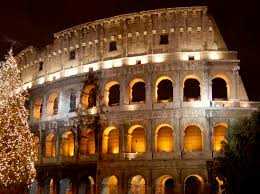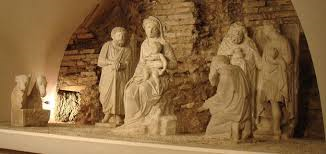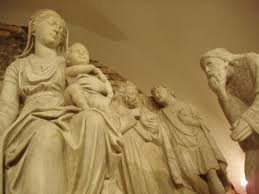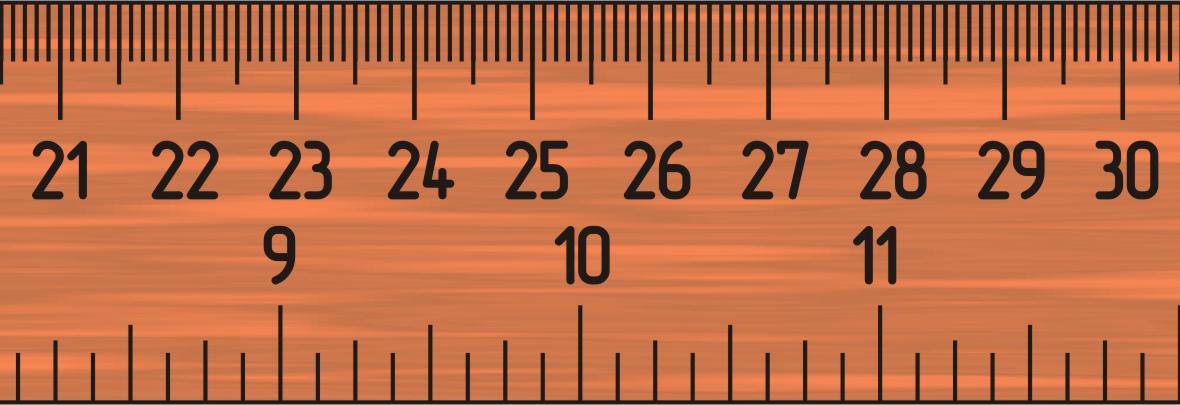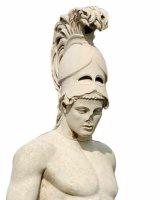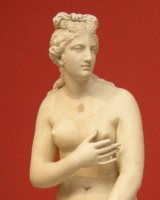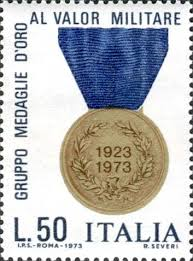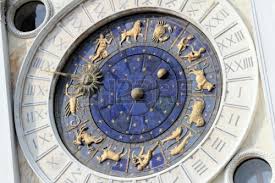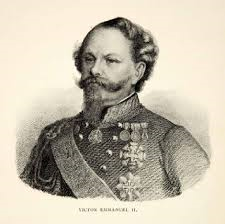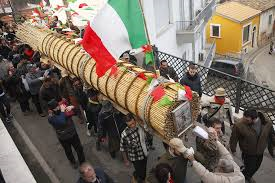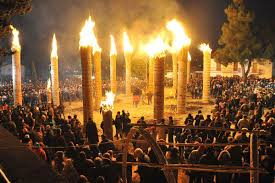

VI FACCIO![]()

e non dimenticate di portare le vostre…
I WISH YOU ALL A VERY
And don’t forget to wear your…
Saturday, December 26, 2015
A TUTTI TO ALL
Saturday December 19, 2015
IL PRESEPE: molte case italiane hanno un presepe di legno o terracotta.
Il primo presepe inerte con tutti i personaggi risale al 1291, quando ad
Arnolfo di Cambio (c. 1240 – 1300/1310), noto scultore perfezionatosi alla
Bottega di Nicola Pisano, fu commissionato il primo presepio inanimato
della storia, dal papa Niccolò IV (1288-1292), francescano, che voleva
celebrare il presepe di Greccio (controllate il blog della settimana scorsa).
Questo presepio scolpito in marmo è conservato nella Basilica di Santa
Maria Maggiore a Roma.
NATIVITY SCENE: many Italian homes have a nativity scene made out of
wood or terracotta.The first non-live nativity scene with all the characters dates back to1291, when
Arnolfo di Cambio (c. 1240 – 1300/1310), renowned sculptor schooled at the Studio
of Nicola Pisano, was commissioned to sculpt the first non-living nativity scene in
history by Pope Niccolò IV (1288-1292), a Franciscan who wanted to celebrate the
nativity of Greccio (see last week’s blog). This nativity scene, sculpted in marble,
is housed in the Basilica of Santa Maria Maggiore in Rome.Saturday December 12, 2015
IL PRESEPE VIVENTE: l’avvicinarsi del 25 dicembre mi fa pensare a una
dellebellissime tradizioni natalizie che è celebrata per tutta l’Italia.Secondo l’Enciclopedia Cattolica: La tradizione, tutta italiana, del presepio risale
all'epoca di san Francesco d'Assisi. Nel 1220 san Francesco aveva visitato la terra
santa compresa Betlemme…Tornato in Italia, nel Natale del 1223 realizzò a
Greccio in Umbria la prima rappresentazione vivente della Natività di Gesù con
l'aiuto di un amico, Giovanni da Greccio, signore della zona. Tommaso da Celano
riporta le parole che san Francesco gli disse: “Vorrei rappresentare il bambino nato
a Betlemme, e in qualche modo vedere con gli occhi del corpo i disagi in cui si è
trovato per la mancanza delle cose necessarie a un neonato, come fu adagiato in
una greppia, e come giaceva sul fieno tra il bue e l’asinello.” Arrivarono pellegrini
anche da altri borghi; “ciascuno portando secondo le sue possibilità, ceri e fiaccole
per illuminare quella notte.”LIVE NATIVITY SCENE: with the approach of December 25th I am thinking of
one of the beautiful Christmas traditions held throughout Italy.According to the Catholic Encyclopedia the completely Italian tradition of the
nativity dates back to the time of Saint Francis of Assisi. In 1220 Saint Francis
visited the Holy Land including Bethlehem…upon returning to Italy, during
Christmas of 1223 in the town of Greccio in Umbria, he reenacted the first live
representation of the Nativity of Jesus with the help of a friend, Giovanni da
Greccio, a local nobleman. Tommaso da Celano quotes the words spoken by Saint
Francis to his friend: “I would like to show the child born in Bethlehem, and in
some way see with human eyes the discomforts in which he had found himself due
to the lack of the necessary things for a newborn, how he was placed in a manger,
how he lay on the hay between the oxen and the donkey.” Pilgrims came even from
other hamlets; “each one bringing according to his ability, candles and torches to
light up that night.”Saturday December 5, 2015
CONNETTIVI—PARTE SECONDA CONJUNCTIONS—PART TWO
Aggiungiamo alla lista della settimana scorsa dei connettivi più comuni:
Let’s add to the list from last week of the most common conjunctions:
Mentre: while, during , whereas
Mentre Gianni guardava la televisione, sua sorella studiava.
While Gianni watched television, his sister studied.Comunque: anyway, in any case, even so, anyhow, however, no matter how
Comunque vadano le cose, puoi sempre contare su di me.
However things go, you can always count on me.Perciò: therefore, for this reason
Non è venuto, perciò non ho potuto consegnargli la tua lettera.
He didn’t come; therefore I couldn’t give him your letter.Inoltre: furthermore, also, moreover
T’invio inoltre una fotocopia dell’articolo, così la puoi leggere a tuo agio.
Furthermore, I will send you a copy of the article, so you can read it at
your leisure.
Ad esempio: for example
Sono occupatissima a questo periodo, ad esempio oggi ho insegnato tre
classi e ho fatto una traduzione dall’inglese all’italiano. I’m extremely busy
at this time, for example today I taught three classes and did a translation
from English into Italian.
Riguardo a: regarding
Riguardo a questo problema, i candidati alle elezioni non hanno le idee
chiare.
Regarding this problem, the candidates to the elections don’t have their
ideas straight.
Nonostante: in spite of, despite, although, nevertheless
Nonostante glielo avessi chiesto una decina di volte, non ha eseguito il
lavoro
In spite of having asked him about ten times, he didn’t do the work.Dunque: therefore, so, well
Penso, dunque sono.
I think therefore I am.
Cogito ergo sum.
Je pense, donc je suis.Saturday November 14, 2015
CONNETTIVI—PARTE PRIMA CONJUNCTIONS—PART ONE
Secondo il dizionario Garzanti Linguistica, il gruppo “i connettivi” nella linguistica
testuale si riferisci a qualsiasi parola (per lo più congiunzione), espressione, o
frase che collega due segmenti o blocchi di testo. Spesso questi confondono gli
studenti d’italiano. Perciò nelle prossime settimane, daremo un’occhiata ad
alcuni connettivi tra i più comuni.According to the Garzanti Linguistica dictionary, a conjunctive refers to any word
(generally a conjunction), expression, or phrase what joins two segments or
blocks of text. These often are confusing to students of Italian. Therefore
during the next several blog entries we will look at a few of the most common
conjunctives:nsomma: so, therefore, in conclusion, but really, so-so
Domanda: Com’era la festa? Question: How was the party?
Risposta: Insomma… Answer: So-so…Siccome: given that, because, since
Siccome non c'era nessuno, abbiamo lasciato un biglietto.
Since no one was home, we left a note.Affinché: so that, in order that
Affinché il suo sogno diventi realtà, dovrà vincere la lotteria.
In order that his dream become reality, he will have to win the lottery.Però: but, yet, however, though, well wow
È una macchina vecchia, però funziona ancora bene.
It’s an old car, but it still works well.Ossia: that is, in other words
Dante Alighieri, ossia l’autore di La divina commedia, nacque a Firenze.
Dante Alighieri, that is the author of The Divine Comedy, was born in
Florence.
Ovunque: wherever, everywhere
Ti seguirò ovunque tu vada.
I will follow you wherever you go.Tuttavia: however, nevertheless
Non te lo meriti, tuttavia soltanto per questa volta ti aiuterò.
You don’t deserve it, however just this time I’ll help you.Anche se: even if
In quella città si possono fare molte belle passeggiate, anche se le
strade non sono asfaltate.
In that city you can take some lovely walks, even if the streets aren’t
paved.
Saturday November 7, 2015
Tabella conversione misura—scarpe
ITALIA
USA-donne/women
USA-uomini/men
Inches/Pollici
Centimetri
32
8 ⅓
21,4
33
8 ⅝
22,0
34
8 ⅞
22,5
35
5 ½
4
9
22,8
35 ½
6
4 ½
9 ⅛
23,1
36
6 ½
5
9 ¼
23,5
37
7
5 ½
9 ¼
23,5
37 ½
7 ½
6
9 ½
24,1
38
8
6 ½
9 ⅝
24,5
38 ½
8 ½
7
9 ¼
24,8
39
9
7 ½
9 ⅞
25,1
40
9 ½
8
10
25,4
41
10
8 ½
10 ⅛
25,7
42
11
9
10 ¼
26,0
43
12
10 ½
10 ½
26,7
44
13
11 ½
10 ¾
27,3
45
14
12 ½
11
27,9
BUON DIVERTIMENTO!
Saturday October 31, 2015

Labella conversione taglia-vestiti
e precedenti misurazioni che ho descritto le settimane precedenti sono
utili ma molti di voi vanno in Italia volendo comprare un abito. Perciò
vediamo le misure USA e quelle italiane:
Small-Medium-Large
ITALIA
USA
X-Small
36
2
Small
38
4
Small
40
6
Medium
42
8
Medium
44
10
Large
46
12
Large XL/1X
48
14
X-Large/1X
50
16
1X-2X
52
18
2X
54
20
3X
56
22
3X
58
24
E se volete comprare un paio di scarpe? Dovete aspettare la settimana
prossima.The measurements I described in prior weeks are useful, yet many of
you go to Italy wanting to buy an outfit, therefore let’s take a look at
American and Italian sizes.And if you want to buy a pair of shoes, tune in next week.
Saturday October 24, 2015
Centimetri e pollici
Per qualche ragione, questo mese è dedicato alle misurazioni. Fin ora
abbiamo parlato di temperatura e peso, e adesso ci dedichiamo alle
distanze.Dobbiamo tenere in mente che un metro equivale a 100 centimetri, e un
piede equivale a 12 pollici, e una iarda equivale a 3 piedi, perciò:# di centimetri = # di piedi (ovvero 12 pollici) moltiplicati da 30,48; e
# di piedi (ovvero 12 pollici) = centimetri divisi da 30,48.
Il modo più semplice è: un piede equivale (circa) a 30 centimetri, e un
metro equivale più o meno a una iarda (3 piedi).For some reason, this month is dedicated to measurements. Up to now
we have talked about temperature and weight, now we will deal with
distance.We have to remember that a meter equals (more or less) 100
centimeters and a foot equals 12 inches, and a yard equals 3 feet,
therefore:# of centimeters = # of feet (12 inches) multiplied by 30.48; and
# of feet (12 inches) = centimeters divided by 30.38.
However, the easiest way is: a foot is approximately equal to 30
centimeters and a meter is about equal to a yard.Saturday October 17, 2015
Chilogrammi e libre
La settimana scorsa abbiamo parlato di temperatura, adesso tocca al peso.
Per fortuna, in questo caso, le formule sono molto più facili:
Se vogliamo convertire libre a chilogrammi:
# di libre divise da 2,2 = chilogrammi;
e l’opposto, da chilogrammi a libre:
# di chilogrammi moltiplicati per 2,2 = libre.
Last week we talked about temperature, now it’s weight’s turn.
Luckily, in this case the formulas are much easier:
If we want to convert pounds to kilograms:
# of pounds divided by 2.2 = kilos;
and the opposite, from kilos to pounds:
# of kilos multiplied by 2.2 = pounds.
Saturday October 10, 2015
HRENHEIT E CELSIUS
Se vi trovate in Italia e dovete calcolare la temperatura e non avete a
disposizione il vostro telefonino tuttofare, ecco alcune formule utili:Per convertire da Fahrenheit a Celsius:
1. Prendere la temperatura Fahrenheit e sottrarne 32;
2. Dividere la risposta per 9;
3. Moltiplicare la risposta per 5, ed ecco fatto!
Per fare l’opposto, convertire da Celsius a Fahrenheit:
1. Moltiplicare la temperatura Celsius per 9;
2. Dividere la risposta per 5;
3. Aggiungere 32!
Facile, no? Per me, la soluzione alla buona è ricordare solo qualche
temperatura equivalente, vi do la mia forma breve:
Celsius Fahrenheit 10° 50° 20° 68° 30° 86° 40° 104° Se notate la differenza ogni 10° Celsius è di 18° Fahrenheit. Non vi
consiglio questa formula se dovete svolgere un esperimento
scientifico, ma per una temperatura approssimata, va benissimo!----------
If you find yourselves in Italy and you have to calculate the
temperature and you don’t have your all-purpose phone at your
disposal, here are some useful formulas:To convert from Fahrenheit to Celsius:
1. Take the Fahrenheit temperature and subtract 32;
2. Divide the answer by 9;
3. Multiply the answer by 5, and there you have it!
To do the opposite, to convert Celsius to Fahrenheit:
1. Multiply the Celsius temperature by 9;
2. Divide the answer by 5;
3. Add 32!
It’s easy, isn’t it? For me, the simplest solution is to remember a few
temperature equivalents; I’ll give you my shorthand version:
Celsius Fahrenheit 10° 50° 20° 68° 30° 86° 40° 104° If you notice, the difference between every 10° Celsius is 18° Fahrenheit. I don’t
recommend this formula if you have to do a scientific experiment, but for an
approximation, it’s great!Saturday October 3, 2015
ALL’OSPEDALE: Dio ce ne scampi e liberi! Questo vocabolario potrebbe essere
utile.AT THE HOSPITAL: God forbid! This vocabulary may prove useful.
Numeri d’emergenza Emergency numbers 112-generale in tutta l’Europa 112-throughout Europe 112-Carabinieri (in Italia) 112-Carabinieri (military police-in Italy) 113-Polizia (in Italia) 113-Police (in Italy) 115-Vigili del fuoco (in Italia) 115-Fire (in Italy) 116-Soccorso stradale (in Italia) 116-Roadside assistance (in Italy) 118-Emergenza sanitaria (in Italia) 118-Ambulance/Medical Emergencies (in Italy) Italiano: English: ambulanza ambulance barella stretcher sedia a rotelle wheelchair pronto soccorso emergency room infermiera/infermiere nurse radiografia/raggi X X-rays radiologia radiology diagnosi diagnosis sala operatoria operating room intervento chirurgico/operazione operation fare un intervento to operate chirurgo surgeon anestesista anesthesiologist anestesia anesthesia sala di recupero recovery room reparto/unità di terapia intensiva ICU (Intensive Care Unit) iniezione injection flebo intravenous Saturday September 26, 2015
LA FARMACIA: Se per caso aveste bisogno di farvi preparare una ricetta
dopo la vostra visita dal dottore o dal dentista, o di una cosa più semplice
come dello shampoo o prodotti di bellezza, andrete in farmacia.THE PHARMACY: If you need to fill a prescription after your visit to the
doctor or dentist, or even something less complicated as shampoo or
beauty products, you will go to a pharmacy or drug store

La farmacia italiana non vende solo farmaci, ma anche occhiali da sole,
profumo, gomma da masticare, ecc. Se avete bisogno di una consulenza,
la/il farmacista vi può aiutare; ricordiamo di darle/gli del dottore.The pharmacies in Italy don’t only sell medicines, they also sell
sunglasses, perfume, chewing gum, etc. If you need some advice, the
pharmacist can help you, just remember to refer to her/him as doctor.
Italiano: English: medicinale di marca brand name medicine farmaco generico/medicinale
equivalentegeneric drug medicinali da banco over-the-counter drug medicina con ricetta prescription drug dosaggio dose pomata ointment/salve crema cream pillola/pastiglia pill capsula gel gel-cap aspirina aspirin acetaminofene acetaminophen sonnifero sleeping pill cerotto band-aid antibiotico antibiotic garza gauze nastro adesivo tape antisettico disinfectant benda elastica ace-bandage batuffolo di cotone cotton ball smalto per le unghie nail polish acetone nail polish remover il pettine comb la spazzola brush profumo perfume i cosmetici cosmetics
Adesso tocca a voi di allungare la lista secondo le vostre esigenze personali.
Now it’s your turn to add to this list according to your personal needs.Saturday September 19, 2015
DAL DOTTORE: Poco tempo fa ho avuto un intervento chirurgico e
ho pensato che un po’di vocabolario medico possa essere utile—ma
speriamo di non dovrelo mai usare.
Espressioni usate dal paziente:
Non mi sento bene. Sono malato/a.
Soffro di mal di testa/gola/pancia/schiena.
Mi fa male il braccio sinistro/destro.
Sono caduta/o e adesso ho una caviglia gonfia.
Ho la nausea.
Non so se soffro di raffreddore o d’influenza.
Ho la febbre a 40°.
Espressioni usate dal dottore:
Apra la bocca.
Respiri profondamente.
Le voglio misurare la pressione del sangue.
Ho bisogno di un campione di sangue/urina.
Vorrei fare delle analisi del sangue.
È allergico a qualche medicina?
Le prescrivo degli antibiotici, deve prendere
tre pillole il giorno.Not long ago I had surgery and I thought that some medical
vocabulary could prove useful, let’s hope, however, that it
will never be necessary.
Expressions used by the patient:
I don’t feel well. I’m sick.
I have a headache/a sore throat.
My stomach/back hurts.My left/right arm hurts.
I fell and now my ankle is swollen.
I feel nauseous.
I don’t know if I have a cold or the flu.
I have a fever of 104⁰.
Expressions used by the doctor:
Open your mouth.
Breathe deeply.
I want to take your blood pressure.
I need a blood/urine sample.
I want to do a blood test.
Are you allergic to any medicines?
I will prescribe an antibiotic; you have to take three pills a day.
Saturday September 5, 2015
Come molti italiani facevano anni fa, ho deciso, per il mese d’agosto
di andare: in ferie.Auguro buone vacanze a tutti!
Like many Italians did years ago, I have decided to take the month
of August off,I’m on vacation.
I wish all of you happy holidays!
Saturday August 1, 2015
7° 8° 9° 10° = 9° 10° 11° 12°! Come può essere?
- Settembre: dal latino septimo, a sua volta da septem, "sette",
perché era il settimo mese del calendario romano, che iniziava da
marzo. Il nome fu sostituito per brevi periodi da "Germanico" in
onore del padre dell'imperatore Caligola e poi per celebrare una
vittoria dell'imperatore Domiziano e da "Amazonius" per volere dell'
imperatore Commodo.
- Ottobre: il nome deriva dal latino octo, "otto" perché secondo il
calendario romano composto di soli 10 mesi, risultava essere
l'ottavo mese. Per un breve periodo fu chiamato Invictus in onore
dell'imperatore Commodo, ma dopo la sua morte riprese il nome
originale.- Novembre: dal latino novem, "nove"; era il nono mese del
calendario romano che iniziava da marzo. Secondo la tradizione
longobarda fino al 470 a.C. era seguito da Maglio, mese dedicato
alla caccia imperiale.- Dicembre: deriva dal latino decem ossia "dieci"; nel calendario
romano era il decimo mese perché non esistevano ancora gennaio e
febbraio inseriti in seguito da Numa Pompilio.
THE ORIGINS OF THE NAMES OF THE MONTHS OF THE YEAR—PART II
7th 8th 9th 10th = 9th 10th 11th 12th! How can that be?
September: from the Latin septimo, and in turn from septem, seven,
because it was the seventh month of the Roman calendar, which began
with the month of March. The name was substituted for brief periods by
“Germanico” in honor of the father of the emperor Caligula and
afterwards to celebrate a victory of the emperor Domitian and by
"Amazonius" according to the desires of the emperor Commodus.October: the name derives from the Latin octo “eight” because it was
indeed the eighth month according to the Roman calendar which was
made up of only ten months. For a brief period it was called Invictus, in
honor of the emperor Commodus, but after his death it took back the
original name.November: from the Latin novem “nine” it was the ninth month in the
Roman calendar which began with March. According to the Longboard
tradition until 470 AD, it was followed by Maglio, the month dedicated to
the imperial hunt.December: from the Latin decem or “ten”, it was the tenth month in the
ancient Roman calendar in that January and February did not yet exist,
and were subsequesntly added by Numa Pompilio.Saturday July 25, 2015
THE ORIGINS OF THE NAMES OF THE MONTHS OF THE YEAR—PART II
- Maggio: il nome Maius potrebbe derivare dalla dea romana Maia
(antica dea della fertilità, della terra e dell'abbondanza). Per i
cristiani Maggio è il mese dedicato alla Madonna.- Giugno: Iunius fu denominato anche mese del Sole o della Libertà.
Il nome deriva da quello della dea Giunone (rappresentata più giù)
antica divinità del matrimonio e del parto, regina degli dei e moglie
di Giove. Altri dicono che deriva da Junio Bruto, fondatore
dell’antica Repubblica romana. Altri invece dicono che il mese è
dedicato alla gioventù.- Luglio: nel calendario di Romolo, era chiamato Quintilis, da quinque,
ossia "cinque" perché era appunto il quinto mese dell'anno. Assunse
nel 44 a.C. il nome di Julius in onore del console Gaio Giulio Cesare,
nato il 13 di questo mese.- Luglio: nel calendario di Romolo, era chiamato Quintilis, da quinque,
ossia "cinque" perché era appunto il quinto mese dell'anno. Assunse
nel 44 a.C. il nome di Julius in onore del console Gaio Giulio Cesare,
nato il 13 di questo mese.- Agosto: chiamato Sextilis nel calendario romano, nell'anno 8 a.C.,
in onore dell'imperatore Ottaviano Augusto il mese fu rinominato
Augustus. In quell'occasione fu inoltre aggiunto un giorno al mese
per renderlo uguale a Luglio
.
THE ORIGINS OF THE NAMES OF THE MONTHS OF THE YEAR—PART II
· May: from the Latin Maius the name may derive from the Roman
goddess Maia, ancient god of fertility, the earth and plenty. For the
Christians, May is the month dedicated to the Madonna.· June: Iunius was also known as the month of the Sun and of
Freedom. The name comes from that of the goddess June (see above),
ancient goddess of marriage and birth, queen of the dogs and wife of
Jupiter. Others say the name of the month comes from Junio Bruto,
founder of the ancient Roman Rebublic. Still others day that the month is
dedicated to youth.· July: in the Romulus calendar the month was called Quintilis, from
quinque, meaning “five” since it was the 5th month of the year. In 44
BCE it became “Julius” (July) in honor of the consul Gaius Julius Caesar,
who was born on the 13th day of the month.· August: in the ancient Roman calendar it was called Sextilis, but
in the year 8 AD, in honor of the emperor Octavian (Caesar Augustus) it
was called “Augustus” (August). On the occasion one day was added to
the month to make it the same length as July.Saturday July 18, 2015
L’ORIGINE DEI NOMI DEI MESI DELL’ANNO—PARTE I
- Gennaio: il nome deriva dal latino Januarius ed è legato al dio
Giano, divinità romana dell'apertura e dell'inizio. Egli è raffigurato
solitamente con due volti, uno rivolto al futuro e l'altro al passato.
Il mese di Gennaio fu introdotto soltanto nel 713 a.C. da Numa
Pompilio. In precedenza i romani consideravano l'inverno un periodo
senza mesi e l'anno era costituito solo da dieci mensilità.- Febbraio: questo mese non compariva nel calendario di Romolo,
ma fu inserito solo in seguito da Numa Pompilio insieme a Gennaio.
Il suo nome deriva dal latino februare, che significa "purificare" o
"un rimedio agli errori" in onore del dio etrusco Februus e della Dea
romana Febris.- Marzo: la parola deriva dal latino Martius in omaggio a Marte, dio
romano della guerra, ma anticamente riconosciuto anche come
protettore della natura e della fertilità. Marzo rappresentava il
primo mese dell'anno secondo il calendario di Romolo.- Aprile: Aprilis secondo alcune interpretazioni era il mese dedicato
alla dea Venere ed il suo nome deriva dal latino aperire ("aprire")
per indicare il periodo in cui si "schiudono" i fiori. Secondo altre
teorie potrebbe anche derivare dall'etrusco Apro o dal greco per
Afrodite, dea dell'amore.
Marte e Afrodite: alcuni mesi dell'anno sono dedicati a divinità romane
THE ORIGINS OF THE NAMES OF THE MONTHS OF THE YEAR—PART I
· January: the name derives from the Latin Januarius and is tied to
the god Janus, the Roman god of beginning and end. He is usually
represented as a figure with two faces: one turned towards the future
and the other towards the past. The month of January was instituted
only in 713 BCE by Numa Pompilio. Before that, the Romans regarded
winter as a time without months and the year was made up of only ten
monthly periods.
· February: this month did not appear in the Romulus calendar, and
was established by Numa Pompilio along with January. The name
comes from the Latin februare, which means “to purify” or “a remedy
for errors” in honor of the Etruscan god Februus and the Roman
goddess Febris.
· March: the word derives from the Latin Martius in honor of Mars,
Roman dog of war; in ancient times he was also recognized as the
protector of nature and fertility. Mars represented the first month of
the year according to the Romulus calendar.
· April: according to several interpretations, Aprilis was the month
dedicated to the goddess Venus, and the name derives from the Latin
aperireI (to open) to indicated the time when the flowers open/bloom.
According to other theories, the name could derive from the Etruscan
Apro or the Greek for Aphrodite, goddess of love.
Saturday July 11, 2015
COGLIAMO QUEST’OCCASIONE PER AUGURARE A TUTTI I NOSTRI AMICI
STATUNITENSI UN FELICE 4 LUGLIO, GIORNO D’INDIPENDENZA.
WE WISH ALL OF OUR AMERICAN FRIENDS A HAPPY 4TH OF JULY,
INDEPENDENCE DAY.Saturday July 4, 2015
NORIFICENZE ITALIANE—Parte II::
ONORIFICENZE DI STATO: Il presidente della Repubblica può conferire
Onorificenze della Repubblica; queste sono:
- Medaglie (oro, argento, bronzo) al merito o al valore che sono
conferite a persone o entità.- Cavalierato: Cavaliere di Gran Croce; Grande Ufficiale,
Commendatore; Cavaliere Ufficiale; o Cavaliere.- Il Cavaliere può essere di cinque ordini:
1. Ordine al Merito della Repubblica Italiana: per merito
eccezionale per quanto riguarda la nazione;
2. Ordine Militare d’Italia: premia le azioni di unità delle forze
armate o dei soldati che hanno dimostrato competenza,
responsabilità e valore. Il titolo può essere conferito anche dopo
la morte.
3. Ordine al Merito del Lavoro: date a chi ha lavorato con perizia,
contribuendo allo sviluppo della nazione o a migliorare la
situazione per i lavoratori.
4. Ordine della Stella della solidarietà Italiana: data per la
ricostruzione post-bellica d’Italia.
5. Ordine di Vittorio Veneto; riservata per i soldati italiani
prima guerra mondiale.Esistono anche ordini cavallereschi della Casa Reale di Savoia, della
Santa Sede e dell’Ordine di Malta che conferiscono le onorificenze di
Cavaliere e Dama. Diversamente, la Repubblica Italiana conferisce il
rango di cavaliere ma non quello di dama, anche se le donne possono
essere decorate con rango cavalleresco.ITALIAN TITLES—Part II:
State honorifics: The President of the Republic can bestow “honors
of the Republic”. These are:
- Medals (Gold, Silver, Bronze) for merit or valor to persons or
entities.- Knighthood, (I have kept the Italian titles since in some cases
they cannot be translated) they are: Cavaliere di Gran Croce,
Grande Ufficiale, Commendatore, Cavaliere Ufficiale, Cavaliere.- The Cavaliere can be of five Orders:
- Ordine al Merito della Repubblica Italiana (Order of Merit of the
Italian Republic) is for outstanding merit regarding the nation;- Ordine Militare d’Italia (Military Order of Italy) rewards the
actions of units of the armed forces or by soldiers,
demonstrating expertise, responsibility and valor. The title may
be given posthumously;- Ordine al Merito del Lavoro (Order of Merit for Labor) for those
who have worked with skill, contributing to the development of
the nation and to a betterment of the status to workers.- Ordine della Stella della Solidarietà Italiana (Order of the Star of
Italian Solidarity) for the post-war reconstruction of Italy.- Ordine di Vittorio Veneto (Order of Vittorio Veneto) for the
Italian soldiers of the First World War.
In addition, the orders of chivalry of the Royal House of Savoy, the
Holy See and the Order of Malta confer honorifics of Knight and Lady
(Cavaliere and Dama). Oddly, the Italian Republic bestows the rank of
knight but not that of lady, though women may be decorated with
knightly rank.Saturday June 27, 2015
Espressioni divertenti con i vestiti:
Trattare con i quanti bianchi trattare qualcuno con estremo rispetto Portare i pantaloni comandare avere potere in famiglia Nascere con la camicia essere molto fortunati Attaccare il cappello al chiodo sposarsi/stabilirsi Cascarci con tutte le scarpe credere completamente a una falsità Rimanere in mutande perdere tutti i soldi È un altro paio di maniche è una situazione diversa L’abito non fa il monaco come uno si veste non garantisce chi è Fun expressions with clothing, but let’s see what happens to
them in English:
Treat with white gloves handle with kid gloves Wear the pants wear the pants To be born with a shirt to be born with a silver spoon in your mouth Hang your hat on the nail hang your hat Fall with your shoes he fell for it hook, line and sinker Remain in your underwear he lost his shirt It’s another pair of sleeves it’s another kettle of fish The dress doesn’t make the friar you can’t judge a book by its cover Only half of these expressions carry over into English, or at least stay
within the realm of clothing. Nevertheless, have fun with them!Saturday June 20, 2015
TIME= TEMPO, ORA, VOLTA? Non è così facile! It’s not so easy!
A volte dobbiamo tradurre una parola che appare semplice e ci troviamo
davanti una scelta che ci confonde. Prendiamo la parola “TIME” per
esempio.Può essere tradotta come:
- TEMPO:
Il tempo passa velocemente quando si diverte.- EPOCA:
A quell’epoca tutte portavano la minigonna.- ORA:
Ha che ora parte il volo per Roma?- PERIODO:
Siete mai stati a Napa durante il periodo della vendemmia?- VOLTA:
Quel ristorante è buonissimo, ci mangiamo ogni volta che siamo in città.- CRONOMETRARE:
L’allenatore ha cronometrato il corridore
Time flies when you’re having fun.
2. At that time, everyone wore miniskirts.
3. At what time does the flight leave for Rome?
4. Have you ever been to Napa during harvest time?
5. That restaurant is very good; we eat there every time we’re in town.
6. The coach timed the runner.
Saturday June 13, 2015
DARE-parte seconda
Italiano
Come vi ho detto la lista delle espressioni idiomatiche con il verbo DARE
è lunghissima. Abbiamo già visto quattordici usi, oggiconsideriamo
questi altri esempi:
- dare un esame
La settimana prossima devo dare l’esame di laurea, sono
nervosissimo.- dare un film
Danno due film muti al cinema “Archimede”, vuoi venire con me?- dare un passaggio
Quando era più giovane, Nicola dava un passaggio a chiunque ne
avesse bisogno, oggi però è più cauto.- dare un pugno/calcio
I rapinatori hanno dato un sacco di pugni e calci all’addetto alla
sicurezza della banca.- darsi delle arie
Non so chi si crede di essere, lui si dà tante di quelle arie.- darsi per vinto
C’è ancora tempo prima della fine della partita, non diamoci per
vinti.- darsi da fare
Se non vi date da fare, perderete il treno.- dare la precedenza
Quando si arriva a un incrocio, si deve dare la precedenza alla
destra.- dare alla luce
La mia gatta ha dato alla luce sei gattini.- dare buca a qualcuno
Alessandro mi ha dato buca un’altra volta, non posso più fidarmi di
lui.- dare consiglio
Anna e Maria danno sempre buoni consigli.- dare gas
Forza, dai del gas a questa carretta, vediamo se arriva ai 100
chilometri!- dare l’aspirapolvere
Ho spolverato e dato l’aspirapolvere prima che arrivassero gli ospiti.- dare il cinque
Complimenti, siete arrivati alla fine di questa lista, datevi il cinque,
ve lo meritate!
English
As I told you, the list of idiomatic expressions with the verb DARE is very
long. We have already seen fourteen uses, today let’s consider these
other examples:
- to take a test/exam
Next week I have to take my final exam, I’m really nervous.- to show a movie
They’re showing two silent movies at the Archimedes Theatre,
would you like to come with me?- to give a lift
When he was younger, Nicholas gave a lift to whomever needed one,
but today he’s more cautious.- to punch/kick
The thieves punched and kicked the security guard at the bank- to put on airs
I don’t know who he thinks he is, he puts on (so many) airs.- to surrender/give up
There’s still time before the end of the match, let’s not give up yet.- to get busy
If you don’t get busy you’ll miss the train.- to give way
When you reach an intersection you have to give way to the person
on your right.- to birth
My cat gave birth to six kittens.- to let someone down
Alexander cancelled on me again, I can’t trust him anymore.- to advise
Anna and Maria always give good advice.- to step on the gas
Go ahead, step on it, let’s see if this old heap can go 100
kilometers!- to vacuum
I dusted and vacuumed before the arrival of the guests.- to give high five
Congratulations, you made it to the bottom of this list, give
yourselves a high five, you deserve it!Saturday May 30, 2015
DARE
Italiano
parte prim
La prima volta che uno studente d’italiano incontra il verbo DARE, in
oltre a mandarlo a memoria perché è irregolare (do, dai, dà, diamo,
date, danno) impara delle espressioni idiomatiche.La lista è lunghissima, e piano piano ripasseremo degli usi. Per ora
consideriamo questi esempi:
- dare da mangiare/da bere
Ti sei ricordata di dare da mangiare al cane?- dare del tu
Dopo tutto questo tempo, credo che sia venuta l’ora di darci del
tu, sei d’accordo?- dare fastidio (a)
Quella musica mi dà fastidio, per favore spegnila, sto studiando.- dare i saluti
Quando arrivi a Milano, ti prego di dare i miei saluti ai tuoi
genitori.- dare il benvenuto
I nostri amici ci hanno dato il benvenuto a braccia aperte, sono
molto gentili.- dare la colpa a
Il nostro caporeparto dà sempre la colpa a Francesco, poverino,
è innocente.- dare corda a
Marcellino è viziato, i suoi genitori gli danno sempre corda anche
quando è dispettoso.- dare la corda a
Oggi è raro dare la corda agli orologi perché tutti usano i
telefonini.- dare la mano
In Giappone è raro che le persone si diano la mano.- dare una mano
Ho bisogno d’aiuto, per favore mi puoi dare una mano?- dare ragione
A volte, per mantenere la pace tra amici è meglio dargli ragione.- dare torto
Sono proprio stufa, ogni volta che apro bocca mi dà sempre torto.- dare retta a
È una bambina per bene, dà retta ai suoi genitori.- dare su
Abbiamo affittato un appartamento che dà sul mare, è una
meraviglia.
English
The first time a student of Italian encounters the verb DARE, in
addition to memorizing it because it is irregular, she/he learns several
idiomatic expressions.The list is very long, and slowly we will review some of the uses of
this verb. For now let’s consider these examples:
- to feed
Did you remember to feed the dog?- to use the informal means of address (*see further explanation
below)
After all this time, I feel the time has come to use the informal
“tu”, do you agree?- to bother
That music is bothering me, please turn it off, I’m studying.- to give regards to
When you get to Milan, please give my regards to your parents.- to welcome
Our friends welcomed us with open arms, they’re so nice.- to blame
Our supervisor always blames Francesco, poor thing, he’s
innocent.- to cut some slack
Marcellino is spoiled, his parents always cut him slack, even
when he’s mischievous.- to wind
Today it’s rare to wind clocks because everyone uses his/her
cellphone.- to shake hands
In Japan, it’s rare for people to shake hands.- to give a hand
I need some help, could you please give me a hand?- to tell someone s/he’s right
At times, in order to maintain peace among friends, it’s better to
tell them they’re right.- to tell someone s/he’s wrong
I’m sick and tired, every time I open my mouth he tells me I’m
wrong.- to listen to
She’s well behaved, she listens to her parents.- to face
We rented an apartment that faces the sea, it’s magnificent.(* Italian uses both the formal “Lei” and informal “tu” for the singular
form of you.)Saturday May 23, 2015
I MESI DELL’ANNO--un’altra filastrocca
La settimana scorsa abbiamo letto una filastrocca che gli italiani
usano per ricordare quanti giorni ci sono in un mese. Le filastrocche
sono anche utili per insegnare ai bambini alcune caratteristiche di
ciascun mese:Gennaio freddoloso,
febbraio spiritoso,
marzo pazzerello,
aprile mite e bello,
maggio sognatore,
giugno cantatore,
luglio nuotatore,
agosto gran signore,
settembre grappolaio,
ottobre castagnaio,
novembre triste e stanco,
dicembre tutto bianco.
THE MONTHS OF THE YEAR—another nursery rhyme
Last week we read a nursery rhyme that Italians use to remember
how many days there are in each month. Nursery rhymes are also
useful to teach children certain characteristics of each month:The loose translation from the Italian is:
January is cold,
February is funny,
March is a little crazy,
April is mild and beautiful,
May is the dreamer,
June is the singer,
July is the swimmer,
August is the gentleman,
September brings grapes,
October brings chestnuts,
November is sad and tired,
December is all white.
Saturday May 16, 2015
Carissimi lettori, è il mio primo anniversario perciò vi offro il seguente:
INDICE GENERALE: UN ANNO DI VOCI NEL MIO BLOG
Dear Readers, it is my first anniversary, therefore I give you the following:
GENERAL INDEX: A YEAR OF MY BLOG ENTRIES
3 maggio 2014: FALSI AMICI10 maggio 2014: I
YOU
17 maggio 2014: MAGARI
24 maggio 2014: VOLERCI
3 maggio 2014: FALSI AMICI
10 maggio 2014: I
YOU
17 maggio 2014: MAGARI
24 maggio 2014: VOLERCI
1° giugno 2014: METTERCI
7 giugno 2014: BOCCE
14 giugno 2014: FARE
21 giugno 2014: SOCCER TERMINOLOGY
29 giugno 2014: PARTS OF SPEECH
4 luglio 2014: LASCIARE E USCIRE
12 luglio 2014: MA DAI!
19 luglio 2014: PAROLE INVARIABILI
26 luglio 2014: PAROLE CON DUE FORME AL PLURALE—PARTE PRIMA
2 agosto 2014: IN BOCCA AL LUPO!
9 agosto 2014: PLAY
16 agosto 2014: FERRAGOSTO
23 agosto 2014: PAROLE CON DUE FORME AL PLURALE—PARTE SECONDA
30 agosto 2014: MENTRE O DURANTE
7 settembre 2014: L’ARMISTIZIO DELL’8 SETTEMBRE 1943
13 settembre 2014: L’ORIGINE DEI NOMI DELLA SETTIMANA
20 settembre 2014: MAMMONE
28 settembre 2014: STIPENDIO E SALARIO (PARTE I)
4 ottobre 2014: INDICE
11 ottobre 2014: TIZIO, CAIO E SEMPRONIO
18 ottobre 2014: ADDIO – ARRIVEDERCI -- CIAO -- SALVE
25 ottobre 2014: VERBI IMPERSONALI
1° novembre 2014: CONFETTI
8 novembre 2014: BOMBONIERE
15 novembre 2014: TARDI
22 novembre 2014: IN RITARDO
29 novembre 2014: BELLO, BUONO, BRAVO
6 dicembre 2014: MOLTO, TANTO, TROPPO, POCO
13 dicembre 2014: SCHERZO O BARZELLETTA
20 dicembre 2014: BUON NATALE
27 dicembre 2014: BUON ANNO
3 gennaio 2015: GIORNI FERIALI DEL 2015
10 gennaio 2015: DEVO O DEBBO?
17 gennaio 2015: LE FARCHIE DI FARA FILIORUM PETRI
24 gennaio 2015: TIRARE
31 gennaio 2015: TIRARE-ESPRESSIONI IDIOMATICHE
7 febbraio 2015: IL LESSICO DEL CORPO UMANO-PRIMA PARTE
14 febbraio 2015: PROVERBI PER LA FESTA DI SAN VALENTINO
21 febbraio 2015: IL LESSICO DEL CORPO UMANO-SECONDA PARTE
28 febbraio 2015: CON IL VERBO VIVERE SI USA AVERE O ESSERE?
7 marzo 2015: I NUMERI ORDINALI
14 marzo 2015: FESTA NAZIONALE DELL’UNITÀ D’ITALIA
21 marzo 2015: VERBI CHE TERMINANO IN -RRE
28 marzo 2015: STIPENDIO E SALARIO (PARTE II)
4 aprile 2014: PASQUETTA
11 aprile 2014: LAVORARE
18 aprile 2014: ONORIFICENZE ITALIANI-PARTE I
25 aprile 2014: ANNIVERSARIO DELLA LIBERAZIONE D'ITALIA DAL
NAZIFASCISMO
Saturday May 2, 2015

25 aprile: Anniversario della liberazione d'Italia dal nazifascismo
Il 25 aprile 1945 è il giorno in cui il Comitato di Liberazione Nazionale Alta Italia
proclamò l’insurrezione in tutti i territori ancora occupati dai nazifascisti,
indicando a tutte le forze partigiane attive nel Nord Italia facenti parte del
Corpo Volontari per la Libertà di attaccare i presidi fascisti e tedeschi imponendo
la resa. Parallelamente il CLNAI emanò dei decreti legislativi, assumendo il
potere «in nome del popolo italiano e quale delegato del Governo Italiano»,
stabilendo tra le altre cose la condanna a morte per tutti i gerarchi fascisti (tra
cui Mussolini, che fu trovato e fucilato tre giorni dopo). La Liberazione mise così
fine a venti anni di dittatura fascista ed a cinque anni di guerra; la data del 25
aprile simbolicamente rappresenta il culmine della fase militare della Resistenza
e l'avvio effettivo di una fase di governo che porterà prima al referendum del 2
giugno 1946 per la scelta fra monarchia e repubblica – consultazione per la quale
per la prima volta furono chiamate alle urne per un voto politico le donne – e
poi alla nascita della Repubblica Italiana.April 25th: Anniversary of the Liberation of Italy from Nazism and Fascism
April 25, 1945 is the day on which the Comitato di Liberazione Nazionale Alta
Italia (CLNAI), the National Committee for Liberation of Northern Italy declared
a national insurrection in all of the territories still occupied by the Nazis and
Fascists, informing all the partisan troops active in Northern Italy who were part
of the Volunteer Corps for Liberty to attack the Fascist and German leaders
forcing their surrender. At the same time, CLNAI enacted laws, assuming power
“in the name of the Italian people and as the representative of the Italian
Government,” thus establishing, among other things, the death sentence for all
the Fascist leaders (Mussolini among them, who was found and shot three days
later). This Liberation put an end to twenty years of fascist dictatorship and five
years of war; April 25th represents the culmination of an aspect of military
resistance and the beginning of a new governmental phase starting with the
referendum of June 2, 1946 to choose between the monarchy and a republic—
also the first time women were given the vote—and finally the birth of the
Republic of Italy.Saturday April 25, 2015
ONORIFICENZE ITALIANE—Parte I:
NOBILTÀ: Come parte della Costituzione repubblicana, entrata in vigore in Italia
il 1° gennaio 1948, i titoli nobiliari cessano di essere riconosciuti dalla legge
(anche se, in senso stretto, non sono aboliti o vietati), e l'organo di Stato che li
aveva regolati, la Consulta Araldica, è eliminato. Tuttavia i cosiddetti predicati -
denominazioni territoriali o feudali - che erano stati spesso collegati a un titolo
nobiliare con l'uso di una particella nobiliare, come di, da, della,dei, potrebbe
essere ripresa come parte del cognome legale dopo l'approvazione giudiziaria per l
e persone che lo possedevano prima del 28 ottobre 1922 (data dell’ascesa al
potere del fascismo italiano). In pratica, ciò significa che, ad esempio, "Sempronio,
Duca di Tale Paese" o "Tizia, Principessa del Regno" potrebbero diventare
“Sempronio di Tale Paese " o " Tizia del Regno", rispettivamente. Tuttavia, i titoli
vengono spesso ancora utilizzati ufficiosamente in villaggi, club privati e gruppi
sociali. Signore e Signora (che indicavano aristocrazia terriera) sono traduzioni di
"Lord" e "Lady", usati anche nella gerarchia militare e per le persone in posizioni
ufficiali o per i membri dell’élite di una società. Alcuni titoli sono comuni anche in
forma diminutiva come termini di affetto per i giovani (ad esempio per Principino
o Contessina).I titoli nobili sono:
- Re / Regina
- Principe / Principessa
- Duca / Duchessa
- Marchese / Marchesa
- Conte / Contessa
- Visconte / Viscontessa
- Barone / Baronessa
- Coscritto / Coscritta
- Patrizio / Patrizia
- Nobiluomo / Nobildonna
- Cavaliere Ereditario (non esiste un equivalente femminile)
NOBILITY: As part of the republican constitution that came into effect in Italy on
January 1, 1948, titles of nobility ceased to be recognized by law (although they
were not, strictly, abolished or banned), and the organ of state which had
regulated them, the Consulta Araldica, was eliminated. However the so-called
predicati — territorial or manorial designations—that were often connected to a
noble title by use of a word such as di, da, della, dei, could be taken up again as
part of the legal surname upon judicial approval for persons who possessed it prior
to October 28, 1922 (date of the Fascist accession to power in Italy). This meant
that, for example, "John Doe, Duke of Somewhere" or "Jane Doe, Princess of the
Kingdom" might become "John Doe of Somewhere" or "Jane Doe of Kingdom",
respectively. Nonetheless, titles are often still used unofficially in villages, private
clubs and some social settings. Signore and Signora (formerly signifying
landed nobility) are translations of "Lord" and "Lady", used also in the military
hierarchy and for persons in official positions or for members of a society's elite. A
few titles are also common in diminutive form as terms of affection for young
people (e.g. Principino for "Little Prince" or Contessina for "the Little Countess").Saturday April 18, 2015
TO WORK= LAVORARE? Non è così facile! LAVORARE = TO WORK? It’s not so easy!
A volte dobbiamo tradurre una parola che appare semplice e ci troviamo a tu
per tu con una lunga scelta. Prendiamo il verbo “TO WORK” per esempio.Può essere tradotto come:
- LAVORARE:
Vittoria lavora in banca.- FUNZIONARE:
Il mio telefonino non funziona, è rotto.- ATTIVARE:
Sai come attivare il meccanismo di rilascio?- COLTIVARE:
I contadini coltivano la terra.- MODELLARE:
L’artista ha modellato la creta, il risultato era un busto magnifico di
Dante Alighieri.
- Vittoria works in a bank.
- My mobile doesn’t work, it’s broken.
- Do you know how to work the release mechanism?
- The farmers work the soil.
- The artist worked the clay; the result was a magnificent bust of Dante Alighieri.
Saturday April 11, 2015
Il proverbio dice: Natale con i tuoi, Pasqua con chi vuoi.
Il giorno dopo Pasqua ha vari nomi: lunedì dell'Angelo, lunedì di Pasqua,
oppure Pasquetta. È sia una festa religiosa che civile. Da festa religiosa
prende il nome dal giorno in cui le donne andarono alla tomba di Gesù:
Matteo 28 1-6:[1] Passato il sabato, all'alba del primo giorno della settimana, Maria di
Magdala e l'altra Maria andarono a visitare il sepolcro.
[2] Ed ecco che vi fu un gran terremoto: un angelo del Signore, sceso dal
cielo, si accostò, rotolò la pietra e si pose a sedere su di essa.
[3] Il suo aspetto era come la folgore e il suo vestito bianco come la neve.
[4] Per lo spavento che ebbero di lui le guardie tremarono tramortite.
[5] Ma l'angelo disse alle donne: "Non abbiate paura, voi! So che cercate
Gesù il crocefisso.
[6] Non è qui. È risorto, come aveva detto; venite a vedere il luogo dove
era deposto.”Civilmente il lunedì di Pasqua è un giorno festivo, introdotto dallo Stato
italiano nel dopoguerra; è stato creato per allungare la festa della Pasqua,
così come è avvenuto per il 26 dicembre, indomani diNatale.Il lunedì dell'Angelo, in Italia, è un giorno di festa che generalmente si
trascorre insieme con parenti o amici con una tradizionale gita o
scampagnata, pic-nic sull'erba e attività all'aperto.Vi auguro buona Pasqua, buon appetito e buon divertimento! Spero anche
che le vostre uova al cioccolato siano piene di sorprese gradite e
fantastiche.
An Italian proverb states: Christmas with your family, Easter with
whomever you choose.The day after Easter has various names: Angel’s Monday, Easter Monday, or
“Little Easter”. It is both a religious and civilian holiday. The religious holiday
takes its name from the day in which the women went to Jesus’ tomb,
described in Matthew 28 1-6:1In the end of the Sabbath, as it began to dawn toward the first day of the
week, came Mary Magdalene and the other Mary to see the sepulcher.
2 And, behold, there was a great earthquake: for the angel of the Lord
descended from heaven, and came and rolled back the stone from the door, and
sat upon it.
3 His countenance was like lightning, and his raiment white as snow:
4 And for fear of him the keepers did shake, and became as dead men.
5 And the angel answered and said unto the women, Fear not ye: for I know
that ye seek Jesus, which was crucified.
6 He is not here: for he is risen, as he said. Come, see the place where the
Lord lay.The civilian holiday was established by the Italian Government after the Second
World War as a way to lengthen the Easter holiday, as with December 26th, the
day after Christmas.Easter Monday, in Italy, is a holiday that is usually spent with relatives or
friends in a traditional outing or excursion to the countryside, a picnic out on
the grass and other out-of-doors activities.I wish you Happy Easter, fun and a good appetite. I also hope that your
chocolate eggs are full of welcomed and fabulous surprises.Saturday April 4, 2015
In oltre alle differenze tra salario e stipendio di cui abbiamo già parlato,
ci sono altre parole che dovrebbero essere incluse in questo blog.Per rinfrescarci la memoria:
SALARIO: di solito indica la remunerazione del lavoro manuale
dipendente operaio, perlopiù operaio o bracciante agricolo (i cosiddetti col
letti blu);STIPENDIO: indica la paga mensile, sempre del lavoro dipendente, però
di natura impiegatizia o funzionaria (i cosiddetti colletti bianchi).Il salario può essere:
1. A tempo: la retribuzione è correlata al tempo durante il quale il
lavoratore ha prestato la propria opera;2. Cottimo: la retribuzione è proporzionale alla quantità di lavoro
eseguito; o3. Incentivo: la retribuzione è calcolata in modo da premiare il
lavoratore che produce di più degli altri.In oltre a questi due termini ci sono i seguenti:
APPANNAGGIO: è lo stipendio dei regnanti, si tratta, esattamente, di
una “dotazione a favore di principi del sangue o ai capi di Stato”.EMOLUMENTO: compenso straordinario che un impiegato di altissimo
grado può ricevere oltre lo stipendio; per esempio il compenso di una
conferenza.ONORARIO: compenso professionale, conferito a titolo onorifico, la
retribuzione corrisponde per singole prestazioni di servigi.***********************************
SALARY AND PAY (Part II)
In addition to the differences between salary and stipend which we have
already talked about, there are other words which should be included in
this blog.To refresh our memory:
SALARY: usually refers to the remuneration for the work of the dependent
manual workman, mainly a laborer or field hand (the so-called blue collars);PAY/STIPEND: refers to the monthly pay, also for dependent work,
however of a clerical or functionary nature (the so-called white collars);Salary can be:
1. Hourly: the retribution is correlated to the time the employee has
spent on the job;2. Piecework: based on the amount of work produced; or
3. Bonus/Incentive: the worker who produces the greatest quantity and
superior quality is rewarded.Additionally we have the following terms:
APPANAGE: the salary given to rulers, precisely “an endowment provided
to monarchs or heads of state”.EMOLUMENT/FEE: the extraordinary remuneration a high-standing
employee receives in addition to her/his salary, for example for consulting
or lecturing.HONORARIUM: professional remuneration given to holders of honorary
titles which corresponds to individual services rendered.Saturday March 28, 2015
VERBI CHE TERMINANO IN –RRE.
Ci sono dei verbi che non sembrano appartenere a nessuna delle tre
categorie verbali, quelli che terminano in “–rre”. Vediamo di capire la
loro origine e coniugazione, perciò consideriamo il verbo:Addurre, che significa portare o condurre, deriva dal latino ad-ducĕre
alla base della forma arcaica adducere, che spiega le radici in adduc-,
in seguito sincopato* in addurre, lo stesso fenomeno che è alla base
del futuro e del condizionale.
- Presente: adduco, adduci, adduce, adduciamo, adducete,
adducono.
- Imperfetto: adducevo, adducevi, adduceva, adduciamo,
adducevate, adducevano.
- Passato remoto: addussi, adducesti, addusse, adducemmo,
adduceste, addussero.
- Futuro: addurrò, addurrai, addurrà, addurremo, addurrete,
addurranno.Antiche le forme non sincopate: adducerò, adducerai ecc.
Congiuntivo imperfetto: adducessi, adducessi, adducesse,
- Congiuntivo presente: adduca, adduca, adduca, adduciamo,
adduciate, adducano.
adducessimo, adduceste, adducessero.
- Condizionale presente: addurrei, addurresti, addurrebbe,
addurremmo, addurreste, addurrebbero.Antiche le forme non sincopate: adducerei, adduceresti ecc.
- Participio presente: adducente
- Participio passato: addotto
Antico o poetico: addutto.
- Gerundio: adducendo
Si coniugano come addurre:
- Abdurre
- Circondurre
- Condurre
- Dedurre
- Indurre
- Introdurre
- Produrre
- Reintrodurre
- Ricondurre
- Ridurre
- Riprodurre
- Ritradurre
- Sedurre
- Soddurre
- Tradurre
- Trasdurre
(*Ridurre una parola facendo cadere all’interno uno o più fonemi.)
VERBS THAT END IN –RRE.
There are some verbs which don’t seem to belong to any of the three
categories [verbs ending in “–are”, “-ere”, or “–ire”, 1st, 2nd, and 3rd
conjugation respectively], those that end in “–rre”. Let’s try to
understand their origins and conjugations by looking at the verb:Adurre, which means to take or lead. It derives from the Latin form
ad-ducĕre which is the basis for the archaic form of adducer and
explains the root of adduc-, which was eventually syncopated* to
addurre, the same basis for the future and conditional tenses.
- Present indicative: adduco, adduci, adduce, adduciamo, adducete,
adducono.
- Imperfect: adducevo, adducevi, adduceva, adduciamo,
adducevate, adducevano.
- Past absolute: addussi, adducesti, addusse, adducemmo,
adduceste, addussero.
- Future: addurrò, addurrai, addurrà, addurremo, addurrete,
addurranno.Non syncopated forms are ancient: adducerò, adducerai ecc.
- Present subjunctive: adduca, adduca, adduca, adduciamo,
adduciate, adducano.
- Imperfect subjunctive: adducessi, adducessi, adducesse,
adducessimo, adduceste, adducessero.
- Present conditional: addurrei, addurresti, addurrebbe,
addurremmo, addurreste, addurrebbero.Non syncopated forms are ancient: adducerei, adduceresti ecc.
- Present participle: adducente
- Past participle: addotto
Ancient or poetic: addutto.
- Gerund: adducendo
The list of other verbs that are conjugated like Adurre are listed above.
Practice conjugating them yourselves, it’s fun and that double “r” will
keep your tongue rolling!(*Shorten a word by dropping one or more phonemes within the word
itself.)
Saturday March 21, 2015
17 marzo 2015, la "Giornata dell'Unità nazionale, della
Costituzione, dell'inno e della bandiera" è il 154° anniversario
dell’Unità d’Italia.Il 17 marzo del 1861 con la promulgazione della legge n. 4671 del Regno di
Sardegna, la Camera dei Deputati e il Senato approvarono il progetto di
legge e così nacque il Regno d’Italia. Vittorio Emanuele II di Savoia
assunse il titolo di re per sé e per i suoi successori.Nonostante sia festa nazionale, il 17 marzo non è da considerare giornata
festiva e non determina riduzioni dell'orario di lavoro negli uffici.
March 17, 2015, the “Day of National Unity, of the Constitution, of the
National Anthem, and the Flag” is the 154th anniversary of the
Unification of Italy.On the 17th of March 1861 the Chamber of Deputies and the Senate
promulgated the Kingdom of Sardinia law #4671, and thus the Kingdom of
Italy was born. Victor Emmanuel II of the house of Savoy assumed the title
of king for himself and his successors.Although it is a national holiday, March 17th is not considered a
non-working day and does not permit a reduced work schedule in offices.Saturday March 14, 2015
I NUMERI ORDINALI: 1°, 2°, 3°…
Per qualche ragione, gli studenti si trovano con la bocca impastata quando
devono leggere i numeri ad alta voce.Perciò facciamo un piccolo ripasso, i numeri ordinali:
· Indicano la posizione o l'ordine di successione rispetto ad altri numeri:
primo, secondo, terzo...
· Sono variabili nel genere (maschile o femminile) e nel numero (singolare
o plurale); per esempio: il primo giorno del mese, la prima volta che sono
andata in Italia, i primi libri che ho letto, le prime lettere che ho scritto.
· I primi dieci hanno una forma particolare: primo, secondo, terzo, quarto,
quinto, sesto, settimo ottavo, nono, decimo.
· I successivi si formano aggiungendo il suffisso -esimo al numero
cardinale, che di solito perde la vocale finale: undici=> undicesimo,
quindici=> quindicesimo, cento=> centesimo; ma ventitré=>
ventitreesimo, trentatré => trentatreesimo.
· Altri esempi: quattrocentesimo, millesimo, milionesimo, miliardesimo,
ecc.
a. Con i numeri romani (in particolare per i secoli, i papi, i re e le regine):
Dante morì a Ravenna nel XIV secolo, Papa Giovanni XXIII, Re Vittorio
Emanuele III, la Regina Elisabetta II.
b. Con una piccola "o" (per il maschile singolare), una piccola "a" (per il
femminile singolare), una piccola "i" (per il maschile plurale), e una piccola
"e" (per il femminile plurale); soprascritte: 1o= primo, 1a = prima, ecc.
Si prega di notare: Per i giorni del mese, in italiano, usiamo i numeri cardinali,
con l'eccezione del primo giorno che è sempre ordinale, per esempio: ventidue
luglio, sette marzo, ma primo novembre.
*****************************************************************
ORDINAL NUMBERS: 1st, 2nd, 3rd…
For some reason, students find themselves tongue-tied when they have to read
numbers out loud.Therefore, let’s review them; ordinal numbers: OK
· Indicate position or order in relation to other numbers: first, second,
third....
· In Italian they vary according to gender (masculine or feminine) and
number (singular or plural); in English there is no difference; for example:
the first day of the month (“giorno” is a masculine singular word, thus
“primo”), the first time I went to Italy (“volta” is a feminine singular
word, thus “prima”), the first books I read (“libri” is a masculine plural
word, thus “primi”), the first letters I wrote (“lettere” is a feminine plural
word, thus “prime”).
· The first ten have a particular form: first, second, third, fourth, fifth,
sixth, seventh, eighth, ninth, tenth.
· The following are formed by adding the suffix -esimo to the cardinal
number which usually drops the final vowel: undici=> undicesimo,
quindici=> quindicesimo, cento=> centesimo, but ventitré=>
ventitreesimo, trentatré => trentatreesimo.
· Other examples: four hundredth, thousandth, millionth, billionth, etc.
· Are abbreviated:
a. with roman numerals (particularly for centuries, popes kings and queens):
Dante died in Ravenna in the 14th century, Pope John XXIII, King Victor
Emanuel III, Queen Elizabeth II.
b. with a small "o" ("a" for feminine, "i" plural masculine, "e" feminine plural) :
1o= first masculine, 1a = first feminine
Please note: For the days of the month, in Italian, we use the cardinal numbers,
with the exception of the first day which is always an ordinal number, for
example: twenty two July, seven March, but first November.Saturday March 7, 2015
VIVERE: AVERE O ESSERE, quale ausiliare dobbiamo usare?
Ho controllato varie fonti, tra cui l’Academia della Crusca, il Corriere della
Sera, e l’Enciclopedia Treccani, e il consenso è il seguente:Con il verbo “vivere” sono ammessi entrambi gli ausiliari, senza mutamento
di significato. Nei tempi composti il verbo vivere può essere usato, sia con
l’ausiliare essere, sia con l’ausiliare avere (che sembra essere quello più
usato nell’italiano contemporaneo). Tradizionalmente il verbo vivere si
coniuga con l’ausiliare essere nell’uso intransitivo (“Sono vissuto qui a
lungo.”) e con l’ausiliare avere nell’uso transitivo (“Ho vissuto momenti di
gioia.”). Oggi però è ammesso l’ausiliare avere in entrambi i casi.+++++++++++++++++++++++++++++++++++++++++++++++++
With the verb “TO LIVE” which auxiliary should we use: “TO HAVE” or “TO
BE”?I checked various sources among which: the Accademia della Crusca, the
newspaper Corriere della Sera and the Treccani Encyclopedia and the
consensus is the following:When using the verb “to live” both auxiliaries are allowed without altering
the meaning. In the compound tenses the verb “to live” may be used with
the auxiliary “to be” as well as with the auxiliary “to have” (which appears
to be the one most used in contemporary Italian). Traditionally the verb “to
live” was conjugated with the auxiliary “to be” (“I have lived here for a long
time.”) when used intransitively and with “to have” when used transitively
(“I have lived moments of happiness.”). Today however the auxiliary “to
have” is used in both cases.In English however, all this is a moot point because, as we can see from the
examples above, we don’t make the same distinctions, but it is a question that
comes up in class.
Saturday February 28, 2015
IL LESSICO DEL CORPO UMANO-seconda parte
Un paio di settimane fa noi abbiamo imparato otto modi di dire che utilizzano il
lessico del corpo umano. Oggi ne studieremo altri otto. [Come l’altra volta,
troverete la traduzione letterale in inglese tra parentesi quadre.]1. Luigina critica sempre ma lo fa di nascosto, parla dietro le spalle di tutti.
2. Il mio caporeparto non è felice, ha un diavolo per capello, chissà cosa gli
sia successo.
3. Mariangela è una persona veramente in gamba, riesce a fare di tutto.
4. Sono tutte orecchie, cosa vuoi raccontarmi?
5. Lorenzo si è gettato anima e corpo nel suo nuovo lavoro.
6. Dopo tutti gli sforzi cha ha fatto, Chiara è rimasta a bocca asciutta.
7. Era così sicuro del risultato che ci ha scommesso la pelle.
8. Quel ragazzo ha proprio il pelo sul cuore, che peccato.
THE HUMAN BODY-EXPRESSIONS-part two
A couple of weeks ago we learned eight expressions that use the vocabulary of
the human body. Today we will study eight more. [As last time, you will find
the literal English translation in brackets.]1. Luigina always criticizes, but she does it on the sly, she speaks behind
everyone’s back. [shoulders]
2. My manager isn’t happy; he has a bee in his bonnet, who knows what
happened to him. [a devil for hair]
3. Mariangela is really a very capable person, she can do everything. [in legs]
4. I’m all ears, what do you want to tell me?
5. Lorenzo threw himself, heart and soul, into his new job. [soul and body]
6. After all her efforts, Chiara was left empty-handed. [dry-mouthed]
7. He was so sure of the result that he bet the family farm. [his skin]
8. That young man really has a heart of stone, what a shame. [has hair on
his heart]
Saturday February 21, 2015
Tre proverbi:
- Per san Valentino fiorisce lo spino.
- Per san Valentino la primavera sta vicino.
- A san Valentino ogni "Valentino" sceglie la sua "Valentina".
Ma, un’immagine vale più di mille parole.
Three proverbs:
· The honey locust tree blooms for St. Valentine’s Day.
· At St. Valentine’s Day Spring is near.
· For St. Valentine’s Day every Valentino chooses his Valentina.
But, a picture is worth a thousand words.
Saturday February 14, 2015
IL LESSICO DEL CORPO UMANO-prima parte
Ci sono molti modi di dire che utilizzano il lessico del corpo umano. A
volte, hanno una traduzione diretta in inglese, a volte…no. [Troverete la
traduzioneletterale in inglese tra parentesi quadre.]1. Camillo ha sempre la testa fra le nuvole.
2. Ero così preoccupata che ieri notte non ho chiuso occhio.
3. I miei amici mi accolgono sempre a braccia aperte.
4. Ieri sera tra amici abbiamo alzato un po’ troppo il gomito a cena, e oggi
soffriamo di mal di testa.
5. Enrico ha le mani bucate, ha già speso il patrimonio che aveva ereditato
da sua zia l’anno scorso.
6. Impicciati degli affari tuoi, non mettere il naso nei miei!
7. Quando abbiamo gridato “sorpresa”, Mariella è rimasta a bocca aperta.
8. È una delle persone più pigre che conosca, non muove mai un dito per
aiutarmi.
Per ora bastano questi modi di dire, ne studieremo altri tra poco.
THE HUMAN BODY-EXPRESSIONS-part one
There are many expressions that use the vocabulary of the human body.
At times they translate directly into English, and at times…they don’t. [You will
find the literal English translation in brackets.]1. Camillo always has his head in the clouds.
2. I was so preoccupied last night that I didn’t sleep a wink. [close an eye]
3. My friends always welcome me with open arms.
4. Last night, among friends we hit the bottle a little too much, and today
we have a headache. [raised our elbow]
5. Enrico has a hole in his pocket; he has already squandered the estate he
inherited from his aunt last year. [has holes in his hands]
6. Mind your own business; don’t stick your nose in mine!
7. When we shouted “surprise”, Mariella remained openmouthed.
8. He is one of the laziest people I know; he never lifts a finger to help me.
[moves a finger]
For now, these expressions will do; we will study others very soon.
Saturday February 7, 2015
Tirare le cuoia: crepare.
Tirare la giacca: incoraggiare.
Tirare l’acqua/la catena: scaricare l’acqua nel water.
Tirare a campare: prenderlo un giorno alla volta.
Tirare per le lunghe: prolungare.
Tirare in buca: un termine del golf.
Tirare sul prezzo: contrattare.
Tirare acqua al proprio mulino: pensare a se stesso.
Tirare una frecciata: fare un commento maligno.TIRARE-idiomatic expressions
In addition to the meanings and uses we saw last week, there are several
idiomatic expressions, for example:“Tirare” the leather: Drop dead/kick the bucket
“Tirare” the jacket: Encourage
“Tirare” the water/chain: Flush the toilet
“Tirare” to live: Take one day at a time
“Tirare” for the long way: Prolong
“Tirare” a hole: Sink a putt in golf
“Tirare” on the price: Bargain
“Tirare” water to one’s mill: Think of oneself
“Tirare” an arrow: Make an evil commentSaturday January 31, 2015
TIRARE
L’altro giorno in classe mentre si faceva un esercizio sui pronomi doppi,
abbiamo letto la frase “Mi hanno tirato una pallonata al vetro.” I miei
studenti hanno chiesto il significato del verbo “tirare”, perché in Italia
avevano visto la parola scritta su porte (in funzione opposta di “spingere”).Allora, quanti sono gli usi e le traduzioni del verbo “tirare”? Eccone alcuni:
Allungare: Tirare i fii elettrici.
Aspirare: Tirare il fumo di una sigaretta.
Disegnare/tracciare: Tirare una linea per terra.
Lanciare: Tirare la palla.
Muovere verso di sé: Tirare una corda.
Soffiare: Tira molto vento oggi, fa molto freddo.
Sparare: Ha tirato un colpo di pistola
Tendere: Queste gomme non sono equilibrate, la macchina tira da un lato.
In oltre a questi significati e usi, ci sono delle espressioni idiomatiche che
vedremo la settimana prossima.TIRARE
A few days ago in class, while we were working on an exercise on double
pronouns we read the sentence “They threw a ball against the window.” My
students asked me the meaning of the verb “tirare” (pull) because in Italy
they had seen the word written on doors (as opposes to “push”).Therefore, what are the uses and the translations of the verb “tirare”? Here
are a few:Lengthen: the telephone wires.
Inhale: the smoke of a cigarette.
Draw/trace: a line on the ground.
Throw: the ball.
Pull: a rope.
Blow: The wind is really blowing today, it’s very cold.
Shoot: a gun.
Lean: these tires aren’t balanced, the car leans to one side.
In addition to these meanings and uses, there are idiomatic expressions
that we will look at next week.Saturday January 24, 2015
La festa del santo patrono, S. Antonio Abate a Fara Filiorum Petri, è uno
spettacolo che ricorderete per il resto della vita, ve lo assicuro!
Come abbiamo notato nel Blog di due settimane fa, in oltre ai giorni festivi
stabiliti per decreto di legge, in Italia ogni città o paese aggiunge la festività
locale del Santo patrono. Nel paesino di mio nonno, Fara Filiorum Petri
(CH), i faresi celebrano la festa di S. Antonio Abate in un modo particolare:
bruciano le farchie.Il seguito è stato tratto dal sito web del paese stesso, non posso presumere
di spiegarlo meglio di loro. Vi consiglio anche di guardare uno dei video
disponibili su YouTube.Le "farchie"
Il Sant'Antonio di gennaio viene festeggiato con le "farchie". E' una festa
dove sono evidenti i prodromi dei riti carnevaleschi mentre si lasciano
quelli natalizi; il carattere di transizione è evidente nella mescolanza di
usanze tardo-natalizie, come quella inerenti i cibi (crespelle, cauciune,
serpentone) mentre il brio e l'allegria di gruppo sembra preludere al
Carnevale; " il carattere calendariale della festa che coincide con il
periodo invernale: il fuoco purificatore, allontanatore del male, prepara
l'ascesa dell'astro solare necessaria per nuovi e abbondanti raccolti ( ... )
Tra gli aspetti rituali più interessanti di questa festa si distinguono le
tradizioni melodiche teatrali come i canti e le sacre rappresentazioni;
queste ultime, che derivano probabilmente dalle commedie dei santi di
origine spagnola del tardo Rinascimento, raccontano in forma
melodrammatica le vicende di Sant'Antonio nel deserto". (Gandolfi)La leggenda
È tradizione che la festa delle farchie sia stata originata da un miracolo per
intercessione di S. Antonio al tempo dell'invasione francese del 1799.
All'epoca Fara era protetta da un grande querceto che si estendeva fino a
coprire interamente la contrada Colli. Venendo da Bucchianico verso
Guardiagrele i Francesi volevano occupare Fara ma l'apparizione di S. Antonio
nelle vesti di un generale li fermò. Il santo intimò alle truppe di non
oltrepassare la selva e al loro diniego trasformò gli alberi in immense fiamme
che scompigliarono i soldati.Le farchie
Le farchie sono dei fasci cilindrici di canne legati con rami di salice rosso aventi
generalmente un diametro di cm 70-100 e una lunghezza di metri 7-9. Di
solito sono preparate dalle contrade Colli, Madonna, Mandrone, Forma,
Vicenne, Fara Centro, Crepacci, Campo Lungo, Colle Anzolino, Via S.Antonio o
Colle San Donato, Sant'Eufemia, Giardino e Pagnotto, per essere portate
processionalmente il pomeriggio dei giorno 16 gennaio dalle rispettive
contrade sino al Largo antistante la chiesa di S. Antonio Abate, per essere
innalzate ed incendiate con una simpatica rappresentazione coreutica.Come si svolge la festa
Il giorno 16 gennaio dalle contrade partono trattori decorati con sopra le
farchie. E norma che i cortei prima di iniziare il viaggio recitino le litanie
lauretane. Un suonatore di "trevucette" si mette a cavallo della farchia
mentre un tamburino si mette a capo del corteo. I contradaioli scaricano la
farchia poggiandola sul suolo e quindi, al comando di un uomo chiamato
"capofarchia" la innalzano in piedi. Quando tutte le farchie sono alzate si dà
inizio all'incendio. Alcuni mortaretti incendiano la sommità come una grande
torcia.I pani di S. Antonio
Si preparano il giorno 16 ed il 17 vengono benedetti davanti la chiesa di S.
Antonio. Il comitato fa cuocere circa 400 o 500 "rosette" che poi distribuisce a
tutte le famiglie del paese. Si usa magiare questo pane per devozione, e una
porzione la si fa mangiare agli animali domestici per preservarli dai malanni.Il nome "farchia"
L'origine etimologica di "farchia" potrebbe essere ravvisata in "fòrchia" che
tuttora nel dialetto di Palena (CH) significa caprile dal latino fùrcula da cui
farchja in relazione alle canne intrecciate che delimitano il caprile nella stalla;
oppure da " farchjié' canna palustre con cui si impagliavano le sedie o si
bruciavano le setole del maiale. In abruzzese comunque "farchie" indica
anche una fiaccola di canne oppure legna intrecciata a mò di falò che si brucia
la notte di natale o nella festa patronale. Di conseguenza la parola indica
anche l'asta di legno che sostiene il falò bruciato davanti alle chiese la notte di
Natale. (Giammarco, Dizionario, ect. vol.2')The feast day of the patron saint, Saint Anthony the Abbot, is celebrated in
the town of my grandfather’s birth, Fara Filiorum Petri (in the province of
Chieti in the region of Abruzzi). It is a spectacle that you will remember for
the rest of your lives, I promise you!Picture 13 pillars measuring approximately 3 feet in diameter and 25 feet
high, erected in an enormous circle. They resemble a Stonehenge where
the pillars are made entirely by hand out of reeds and tied with willow
branches. As night falls they are set on fire and slowly burn down.I encourage you to look at some of the wonderful videos available on You
Tube.Saturday January 17, 2015
I giorni festivi del 2015
Auguro a tutti voi un felicissimo 2015. Vediamo quello che quest’anno ha
in serbo per noi.I giorni festivi in Italia sono stabiliti per legge, in oltre a
tutte le domeniche, sono i seguenti:
1° gennaio Capodanno 6 gennaio Epifania 6 aprile Lunedì di Pasqua/Pasquetta 25 aprile Festa della Liberazione (Liberazione dal nazifascismo-1945) 1° maggio ta del lavoro o dei lavoratori 2 giugno Festa della Repubblica 15 agosto Ferragosto/Assunzione di Maria 1° novembre Ognissanti/Tutti i santi 8 dicembre Immacolata Concezione 25 dicembre Natale 26 dicembre Santo Stefano In oltre ogni città o paese aggiunge la festività locale del Santo patrono e,
la prima domenica di novembre, si celebra la festa dell’unità nazionale. I
seguenti giorni non sono festivi ma sono stati stabiliti per decreto di legge.
7 gennaio Festa del Tricolore 27 gennaio Giorno della Memoria 17 marzo Anniversario dell’Unità d’Italia 4 novembre Giorno dell’Unità Nazionale e Festa delle Forze Armate Se un giorno festivo cade di domenica, non è trasferito al lunedì
seguente, perciò il numero di giorni festivi varia ogni anno.Italian holidays of 2015:
I wish all of you a very happy 2015. Let’s see what this year has in store
for us. The Italian holidays are established by law, and in addition to every
Sunday they are as follows:
January 1st New Year’s Day January 6th Epiphany April 6th Monday after Easter April 25th Liberation Day (Liberation from Nazi Germany-1945) May 1st International Workers’ Day June 2nd Republic Day (Establishment of the Republic of Italy-1946) August 15th Ferragosto/Assumption Day November 1st All Saints, Day December 8th Feast of the Immaculate Conception December 25th Christmas December 26th St. Stephen’s Day Additionally, every city or town adds the feast day of its local patron
saint, and on the first Sunday of November National Unity is celebrated.
The following days are not days off but have been established as
holidays by law.
January 7th Flag Day January 27th International Holocaust Remembrance Day March 17th Anniversary of the Unification of Italy November 4th National Unity and Armed Forces Day If a holiday falls on a Sunday, it is not transferred to the following Monday,
thus the number of holidays varies every year.Wednesday January 7, 2015
Blog Pages/Years
2025 | 2024 | 2023 | 2022 | 2021 | 2020 | 2019 | 2018 | 2017 | 2016 | 2015 | 2014



